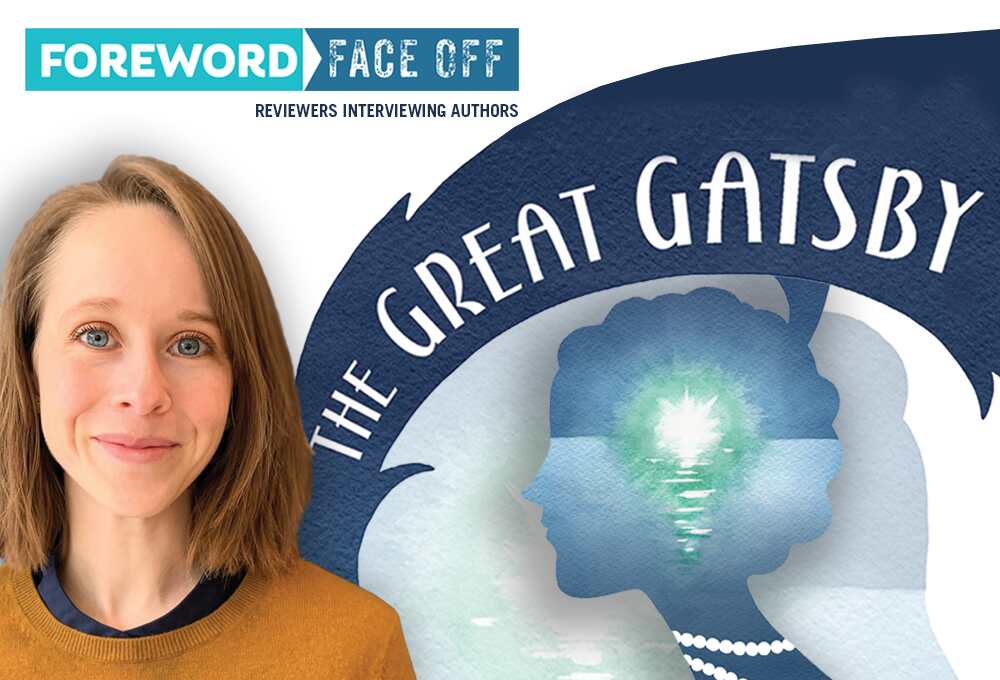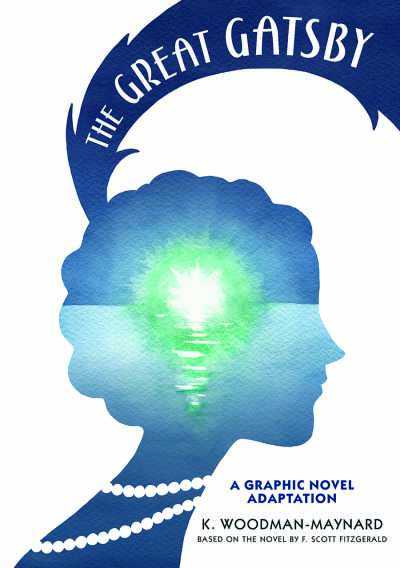Reviewer Peter Dabbene Interviews K. Woodman-Maynard, Author of The Great Gatsby: A Graphic Novel Adaptation

The classics of American literature are continually set upon by admiring screenplaywrights, short story adapters, marketers, and all manner of opportunists seeking to profit by association. Alas, most borrowings are ill advised, embarrassing even, but occasionally magic happens.

Such is the case with K. Woodman-Maynard’s new graphic-novel take on F. Scott Fitzgerald’s masterpiece, The Great Gatsby—“a faithful version of Fitzgerald’s story, with new insights that come from the merging of the written word and graphic arts—the mark of a successful adaptation,” according to Peter Dabbene’s review in the January/February issue of Foreword Reviews.
Thanks to Candlewick, we were able to connect reviewer and author for the following conversation. If you’re intrigued by the creative workings of a modern artist’s mind, you won’t want to miss this one.
Peter, take it from here.
How did this project happen? Were you contacted with the idea, or did you propose it?
A friend and I toyed with the idea of a Gatsby graphic novel back in 2010, but we dreamed of setting it in modern-day San Francisco (where we lived at the time). We only spent a few hours on the idea which was lucky since we had no idea that Gatsby wasn’t yet in the public domain. However, the idea of a Gatsby graphic novel stuck with me, so in 2018 when I was looking for a new project, I thought of it again. But this time, I didn’t want to do a modern-day version. Why would I do that when the 1920s are so visually fabulous and the story is so tied to its time period? I was very lucky that the timing of my project dovetailed with Gatsby entering the public domain.
The Great Gatsby passed into the public domain in 2021, along with books by Virginia Woolf and Ernest Hemingway, among others. Some people see limits on copyright laws, such as the passing of works like The Great Gatsby into the public domain, as a negative for artists’ rights. Others see those limits as essential to the creation of new works, which keep the originals in the public eye and expose their characters to new audiences. What are your feelings about public domain laws? If you could, would you choose to shorten the ninety-five-year wait for works to pass into public domain, or lengthen it?
If I could, I would shorten and simplify the copyright laws as it relates to the public domain. It’s really quite complicated in the US, but in most other countries, the works pass into the public domain seventy years after the author’s death. I personally think that seventy years is long enough for the heirs of the author to guide and benefit from the estate before the public gets to add their own interpretations. And it would simplify things to have the US copyright laws better align with that of other countries.
From looking at your other work, it seems you excel at a variety of art styles. Can you tell us about the process of deciding on your book’s distinctive look, including the decision to use watercolors?
The style I created for this graphic novel was entirely new to me and I developed it so it would fit the mood of The Great Gatsby. My line art is done in a slightly sketchy style that matches the sketchiness of Nick Carraway’s narration and the fact that the book is told from Nick’s unreliable memory. The watercolor is meant to match the lushness and booziness of the story. Previous to this book, I had no experience with watercolor, but it seemed like the best tool for the story, so I learned it.
Your book uses art-deco style fonts for chapter headings, and a number of other visual and design touches that vividly evoke the Roaring Twenties. Do we have your experience as a graphic designer to thank for that?
Yes, my work as a graphic designer definitely influenced those areas especially. But I also grew up watching a lot of Jeeves and Wooster and Hercule Poirot, which are set in the 1920s and 1930s, so aesthetically the time period has resonated with me since I was a child.
In the author’s note, you describe making changes to incorporate your vision and make the story work best as a graphic novel—everything from the surreal sight of a floating Daisy, to depicting her as a blonde instead of a brunette. In other places, you use Fitzgerald’s exact text, including some of his most beautiful and well-known prose. How much of this adaptation would you say is you, and how much Fitzgerald?
That is hard to say! In many ways, I was extremely true to the text and invented very little. For instance, the surreal elements I highlight are all taken from the text. When I see other adaptations, I’m surprised at the scenes the creators invent whereas I felt bad adding in an innocuous few lines of dialogue to explain why Tom Buchanan suddenly appears at Gatsby’s house. But at the same time, I cut vast quantities of text from the original novel, so what is seen in the graphic novel is my picking and choosing what’s important for the reader to see. And, of course, you’re seeing my visual interpretation of Fitzgerald’s words. My goal throughout was to capture the mood and emotions in The Great Gatsby, more than being perfectly true to the text.
You have a long relationship with The Great Gatsby, going back to your high school English class. Do you have the same appreciation, and/or desire to adapt other classic works of literature? What’s next for you?
I won’t rule out an adaptation in the future, but I’d have to really love the book, and feel like there was a compelling reason for it to be a graphic novel.
Currently, I’m working on a pitch for a YA graphic memoir which is a very different book from Gatsby, but also has some surreal elements, and is colored with watercolor. It’s also an adaptation of sorts—I’m just adapting my own life instead of a work of fiction.
If you had to summarize Jay Gatsby in a sentence or two, to someone who had no knowledge of the book, how would you describe him?
Jay Gatsby is a mysterious man from humble beginnings who has amassed a huge fortune in order to win back Daisy, a married socialite, whom he had a fling with years before. Gatsby is obsessed, single-minded, and extravagant in his desire to win her back, and can’t let himself see the class divide that will ultimately keep them apart.
Peter Dabbene
